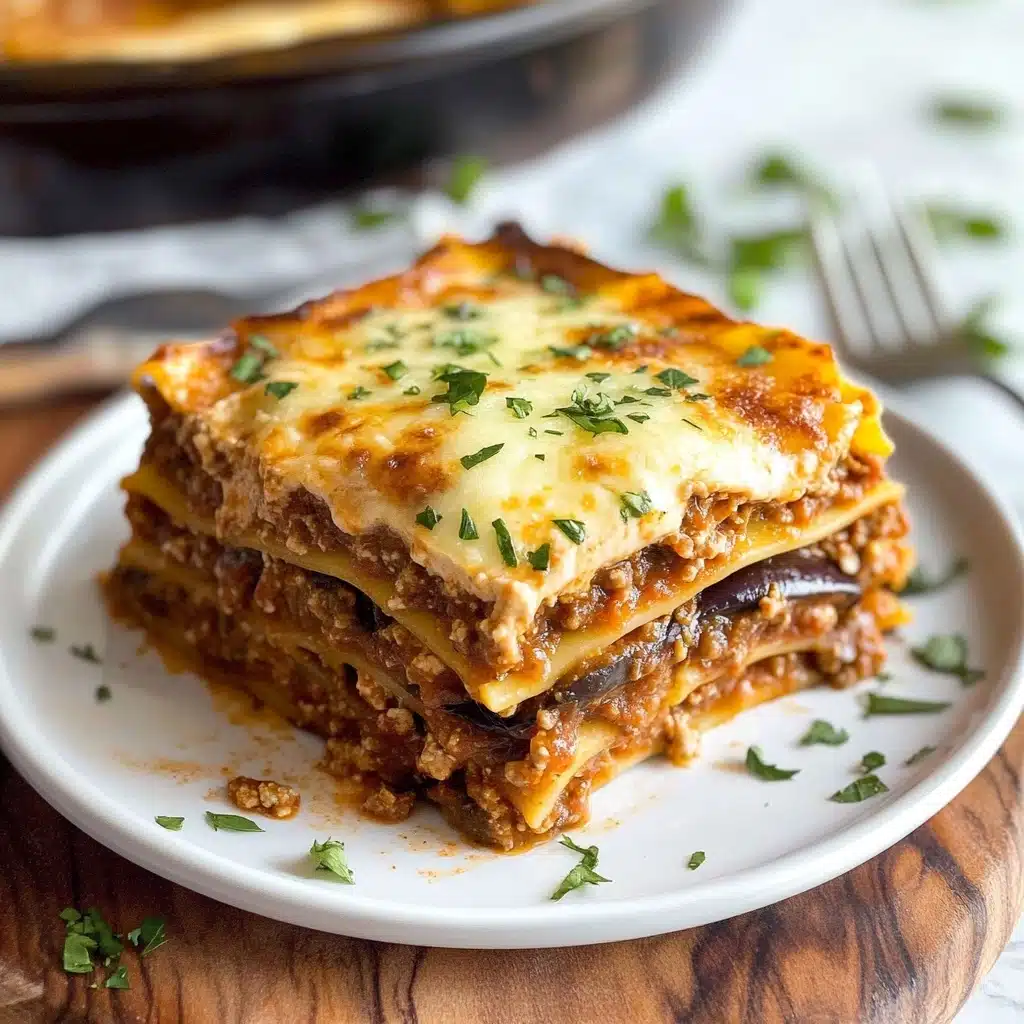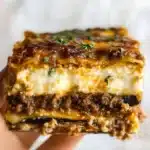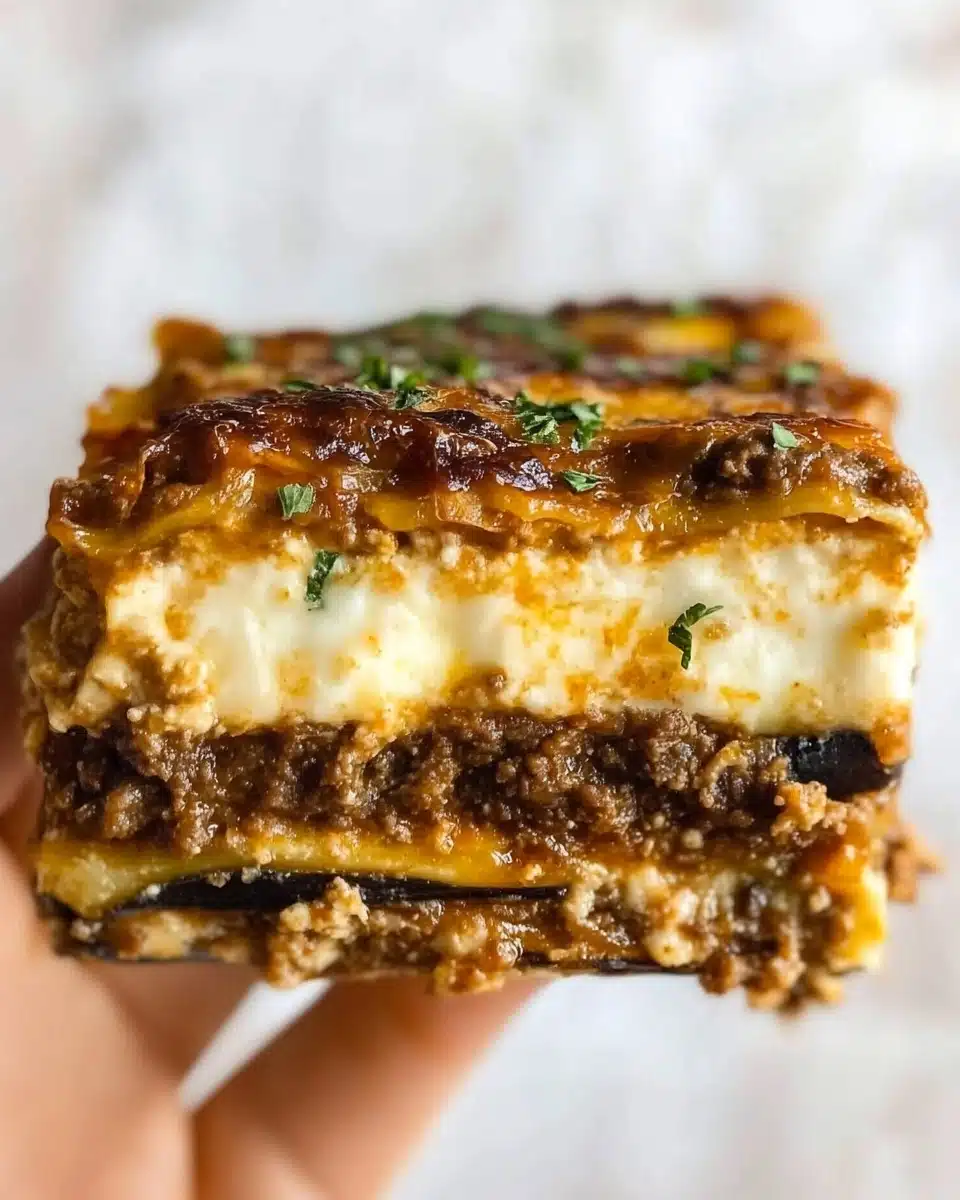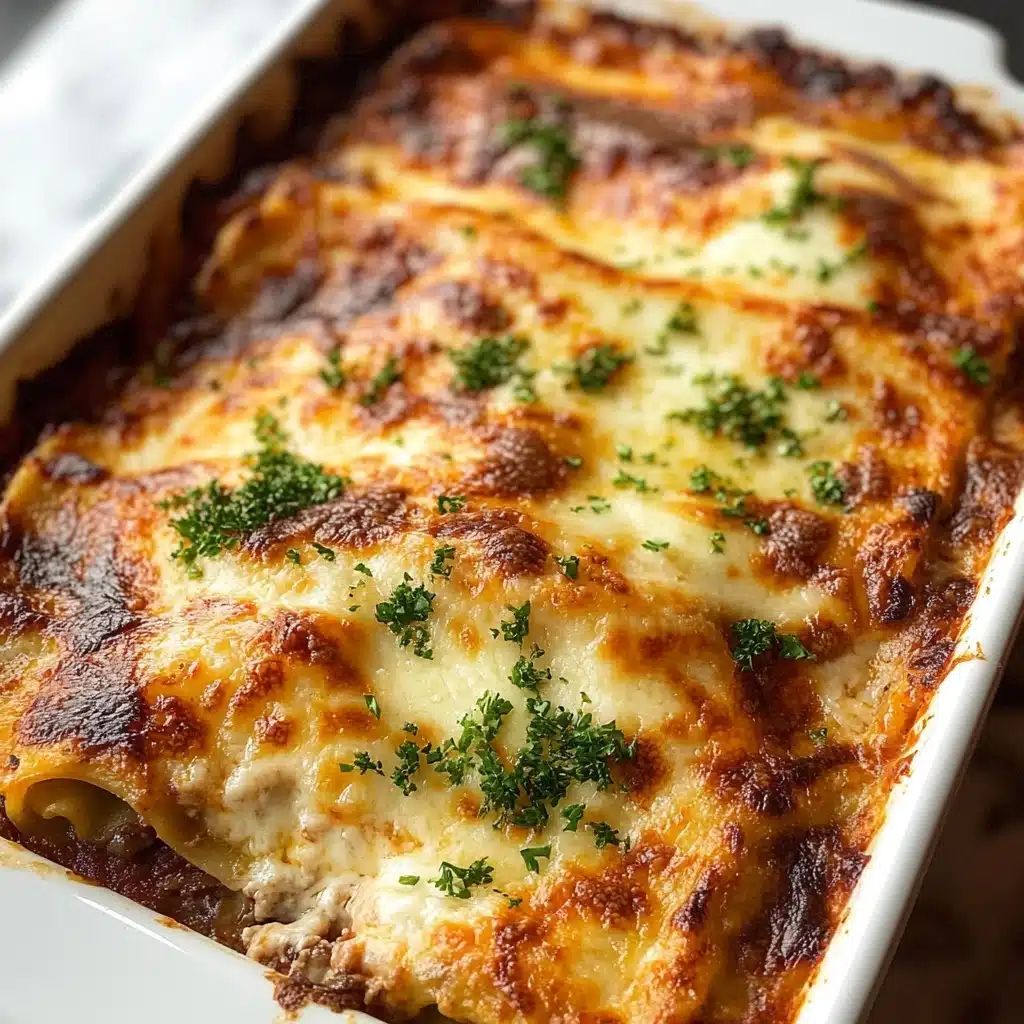This Outrageously Delicious Greek Moussaka is a true Mediterranean masterpiece—layered, luscious, and brimming with fragrant spices and creamy béchamel. Whether you’re already a fan or trying it for the first time, get ready: every forkful offers richly spiced beef, tender vegetables, and that heavenly golden top. It’s hearty, comforting, and absolutely unforgettable!
Why You’ll Love This Recipe
- Ultimate Comfort Food: Each bite is warm, creamy, hearty, and packed with classic Greek flavors you’ll crave again and again.
- Perfectly Balanced Layers: From the cinnamon-spiced beef to the velvety béchamel and savory roasted vegetables, every layer brings something special to the table.
- Make-Ahead Magic: It reheats beautifully, making it a dream for busy weeknights, special occasions, or impressive Sunday lunches.
- Customizable for All: With easy substitutions and dietary twists, your Outrageously Delicious Greek Moussaka can be as unique as your family’s tastes.
Ingredients You’ll Need
Even though the flavors of Outrageously Delicious Greek Moussaka taste exquisitely complex, the ingredient list is refreshingly humble—each one working its magic to create irresistible taste, beautiful color, and that signature melt-in-the-mouth texture.
- Olive Oil: Adds Mediterranean richness, enhances vegetable flavor, and gives the veggies their lovely color—use a fruity one for maximum flavor.
- White Onion & Garlic: The essential aromatic base for sweet, savory depth in the beef layer.
- Ground Beef (750g): Gives this moussaka its heartiness; fairly lean beef is ideal for a saucy, satisfying center.
- Tomato Paste, Passata, & Red Wine: Tomato notes and a hint of red wine create a luscious, tangy sauce with a beautiful hint of complexity. (You can swap wine for more beef stock if you don’t use alcohol!)
- Beef Stock: Deepens the flavor of your meat sauce and brings everything together.
- Fresh Parsley & Thyme: Light, herby, and fragrant—these fresh herbs boost every bite with authentic Greek flavor.
- Bay Leaf, Salt, Black Pepper, Sugar, Cinnamon: The secret to classic Greek moussaka—a touch of cinnamon takes your beef layer from “good” to “unforgettable.”
- Eggplants, Zucchini, Baking Potatoes: These three veggies become meltingly tender and beautifully layered, soaking up flavor as they roast or fry. Go for even slices for neat stacking.
- Unsalted Butter & Plain Flour: The foundation for your creamy béchamel. Always use unsalted butter so you can control the seasoning.
- Milk (room temp): Essential for a lump-free, super-smooth sauce.
- Nutmeg & White Pepper: A pinch of nutmeg elevates the béchamel, while white pepper adds gentle warmth without flecks.
- Pecorino Romano Cheese: Sharp, salty, nutty cheese brings the signature golden crown; sub Parmesan or the more traditional Kefalotiri if you find it.
- Egg Yolks: They’re the secret weapon for béchamel’s luxurious richness.
- Salt & Pepper, Extra Parsley & Cheese (for sprinkling): Season layers generously for bold, vivid flavor all the way through.
- Vegetable or Olive Oil for Frying: Frying gives the veggies irresistible edges—bake for a lighter twist, if you prefer.
Variations
The beauty of Outrageously Delicious Greek Moussaka is how easy it is to tailor—whether you’re working with pantry basics, feeding vegetarians, or skipping gluten, you’ve got plenty of options to make it your own.
- Lamb Moussaka: Swap out beef for lamb to get a richer, slightly gamey flavor that’s also traditional in many Greek kitchens.
- Vegetarian Moussaka: Skip the meat and beef stock—use lentils, mushrooms, or a hearty plant-based mince for a satisfying vegetarian version.
- Potato-Only Base: Not a fan of eggplant? Stack extra potatoes and zucchini for a milder, just-as-comforting base.
- Gluten-Free Béchamel: Use a high-quality gluten-free flour blend (or cornstarch in a pinch) for a creamy sauce everyone can enjoy.
- Lighter “Baked” Veggies: Instead of frying, toss vegetables in olive oil, salt, and pepper, then bake as directed for a lighter, less oily moussaka.
How to Make Outrageously Delicious Greek Moussaka
Step 1: Prepare the Rich Meat Layer
Begin by heating your olive oil in a large, heavy-based pan over medium heat. Sauté the finely diced onion until it’s beautifully soft and just golden, stirring in the garlic for that classic aroma. Add the ground beef, breaking it apart and letting it brown all over. Stir in the tomato paste for a couple of fragrant minutes, then splash in the wine, letting any caramelized bits lift off the pan. Add the passata, beef stock, parsley, thyme, cinnamon, salt, sugar, pepper, and bay leaf—then let it all simmer, uncovered, for about 30 minutes until thick and deeply aromatic. This brings the Outrageously Delicious Greek Moussaka foundation to life!
Step 2: Prep the Veggies
Lay out your eggplant, zucchini, and potato slices on layers of paper towels, sprinkling a pinch of salt over each layer. Top with more paper towels as you go, gently pressing to remove extra moisture (and bitterness from the eggplant). This gives your layers the best possible texture and flavor—don’t rush this step!
Step 3: Cook the Vegetable Layers
Heat enough oil to cover your veggies (about 150°C/300°F for potatoes, upping the heat a bit for zucchini and eggplant). Fry each batch until lightly golden and fork-tender, then transfer to fresh paper towels to drain excess oil. If you’re opting for the lighter baked method, roast each veggie type on lined trays—potatoes first, then eggplant, finishing with zucchini until all are golden and just tender.
Step 4: Whisk Up the Creamy Béchamel
Melt the butter in a clean pot over medium heat, then add the flour—cooking for a minute until it smells toasty. Gradually whisk in the milk, a little at a time, keeping things smooth and lump-free. Once thick, add your salt, white pepper, and a dusting of nutmeg for that signature warmth. Off the heat, stir in the cheese for luscious melt, then quickly whisk in your egg yolks. (A half-cup of the béchamel will be stirred into your meat sauce—extra flavor, extra silkiness!)
Step 5: Layer & Assemble the Moussaka
Begin with an overlapping layer of cooked potato in your baking dish, followed by a sprinkle of parsley, pecorino, salt, and pepper. Next add a layer of zucchini, then half the eggplant, making sure every gap is filled for a compact base. Gently spread the meat sauce across, top with the remaining eggplant, and pour every last bit of béchamel over the top. Finish with a final snowfall of pecorino.
Step 6: Bake & Rest
Bake your masterpiece at 180°C/350°F for 35–45 minutes, or until gorgeously golden and bubbling with patches of light char on top. Let it rest at least 15 minutes before serving—this helps the Outrageously Delicious Greek Moussaka keep its dazzling layers and allows the flavors to mingle perfectly. Trust me, it’s worth the wait!
Pro Tips for Making Outrageously Delicious Greek Moussaka
- Eggplant Perfection: Thoroughly salting and pressing your eggplant slices removes bitterness and turns them beautifully velvety in the final bake.
- Sauce Thickness Matters: Keep the béchamel thick enough to coat the back of your spoon—too thin, and you won’t get those gorgeous, architectural layers.
- Rest Before Serving: Giving your moussaka 15–20 minutes to rest after baking helps it slice cleanly and keeps those dreamy layers intact.
- Season Every Layer: A little cheese, parsley, and a pinch of salt and pepper between each layer guarantees every bite bursts with flavor.
How to Serve Outrageously Delicious Greek Moussaka

Garnishes
Outrageously Delicious Greek Moussaka truly shines with just a simple flourish—think a handful of extra-fresh parsley or a generous dusting of extra pecorino for savory sparkle. A sprinkle of nutmeg or a swirl of exceptional extra-virgin olive oil on top gives it a final fragrant flourish just before serving.
Side Dishes
This rich and layered dish pairs perfectly with a crisp green salad dressed in lemon and olives, or a platter of fresh tomatoes and cucumbers tossed with a squeeze of olive oil. If you want to go all out, serve with warm pita bread and tzatziki or a tangy Greek yogurt dip to brighten each bite.
Creative Ways to Present
For a dinner party twist, present Outrageously Delicious Greek Moussaka in individual ramekins for everyone to enjoy their own perfect portion—or cut it into neat cubes for a stunning buffet-style spread. Drizzle with olive oil, a little fresh mint, or scatter with microgreens for modern, eye-catching style.
Make Ahead and Storage
Storing Leftovers
If you’re lucky enough to have leftovers, cool your moussaka completely, then cover and refrigerate for up to 4 days. Stored properly, the flavors deepen beautifully and it slices even more neatly the next day.
Freezing
For longer storage, freeze individual portions or the entire moussaka well-wrapped for up to a month. Let it cool fully, then tightly seal it in freezer-safe containers or heavy-duty foil. To serve, thaw overnight in the fridge for best texture.
Reheating
Reheat slices gently in the oven covered with foil at 180°C/350°F until hot all the way through—about 20–25 minutes. If reheating from frozen, allow extra time and remove the foil for the last few minutes for a golden, bubbling top.
FAQs
-
Can I prepare Outrageously Delicious Greek Moussaka in advance for a party?
Absolutely! You can assemble the entire moussaka the day before and refrigerate it (unbaked), then bring to room temperature before baking. Alternatively, bake it fully, let it cool, and reheat before serving—moussaka actually tastes even better after the flavors meld overnight.
-
Is it necessary to fry the vegetables or can I bake them to make it lighter?
You can definitely bake the eggplant, zucchini, and potatoes instead of frying for a lighter twist! Just slice, salt, oil, and roast each separately as directed above—your moussaka will still be rich and comforting, just a little less decadent.
-
What can I use if I don’t have pecorino romano or kefalotiri cheese?
No worries! Substitute with freshly grated parmesan cheese, which brings a similar salty-nutty bite. For extra authenticity, try to find a Greek cheese, but parmesan will do a beautiful job in your béchamel and on top.
-
Can I freeze Outrageously Delicious Greek Moussaka before baking?
Yes! Assemble all layers, wrap tightly, and freeze before baking. When ready, thaw overnight in the fridge, bring to room temperature, and bake as usual for a fresh-from-the-oven result.
Final Thoughts
If you’ve never made Outrageously Delicious Greek Moussaka at home, now’s your moment! It’s a feast for the senses and a genuine labor of love, but every bite is pure, joyful Greek comfort. Trust me—your kitchen will smell incredible and your guests will be wowed. Kali orexi (bon appétit)!
Print
Outrageously Delicious Greek Moussaka Recipe
- Prep Time: 40 minutes
- Cook Time: 1 hour 10 minutes
- Total Time: 1 hour 50 minutes
- Yield: 8 servings
- Category: Baking
- Method: Oven
- Cuisine: Greek
Description
Indulge in the flavors of Greece with this Outrageously Delicious Greek Moussaka recipe. Layers of savory beef, fried vegetables, and creamy béchamel sauce come together to create a truly satisfying dish.
Ingredients
Beef Layer
- 1 tbsp Olive Oil
- 1 large White Onion, finely diced
- 2 cloves of Garlic, finely diced
- 1.6lb / 750g Ground/Minced Beef (preferably fairly lean)
- 2 heaped tbsp Tomato Paste (Tomato Puree in UK)
- 1/2 cup / 120ml Dry Red Wine (can sub more beef stock)
- 1 cup / 240ml Tomato Passata (pureed/strained tomatoes in US)
- 1 cup / 240ml Beef Stock
- 1/4 cup finely diced Fresh Parsley, plus extra to serve
- 1 tbsp finely diced Fresh Thyme Leaves
- 2 small or 1 large Bay Leaf
- 3/4 tsp Salt, or to taste
- 1/2 tsp Sugar
- 1/2 tsp Cinnamon
- 1/4 tsp Black Pepper, or to taste
Béchamel Sauce
- 4oz / 120g Unsalted Butter
- 4oz / 120g Plain Flour
- 4 cups / 1litre Milk, at room temp
- 1/2 tsp Salt, or to taste
- 1/2 small Nutmeg, grated (or 1/4 tsp ground nutmeg)
- 1/4 tsp White Pepper
- 1 cup / 80g freshly grated Pecorino Romano, plus extra to serve (Kefalotiri Cheese is traditional, can also sub parmesan)
- 2 Egg Yolks
Veg Layers (see notes for baking version)
- 2 cups / 480ml Vegetable or Olive Oil, or enough to cover veg in the pan
- 1.6lb / 750g (approx 2 large) Baking Potatoes, peeled & sliced around 1/4″
- 1lb / 500g (approx 2 medium) Zucchini/Courgettes, sliced into approx 1/3″ strips (I do lengthways)
- 2lb / 1kg (approx 4 smallish) Eggplants/Aubergine, sliced around 1/3″ thickness (I do lengthways but you can make more smaller rounds if you wish)
- few pinches of Parsley & Pecorino (to sprinkle in between layers)
- Salt & Pepper, as needed
Instructions
- Beef Layer: Heat 1 tbsp olive oil in a large pan or pot over medium heat. Add the onion and fry until soft and golden, then add in the garlic and fry for a minute or so longer. Add in the beef and fry until completely browned, breaking it up with your wooden spoon as you go. Stir in the tomato paste and fry for a couple of mins, then pour in the wine. Deglaze the pan if needed, then pour in the passata and beef stock. Add in the parsley, thyme, cinnamon, salt, sugar, pepper & bay leaf and give it a good stir. Keep on a gentle simmer for around 30mins, stirring occasionally until nice and thick.
- PREP Veg Layer: Rest a few sheets of paper towel in a row on a flat surface and lay on the eggplant slices. Rub a pinch of salt over both sides, then add two layers of paper towels on top. On top of that, add the zucchini slices, followed by another layer of paper towel. Finish with the potato slices and another layer of paper towel on top. Gently press down to soak up the moisture from all of the layers. You can use tea towels instead if you wish.
- COOK Veg Layer: Heat up enough oil to cover the veg in a suitably sized pan until it gently sizzles (you’re aiming for around 150C/300F). Carefully start sliding in the potato slices and fry both sides until lightly golden, with the potato fork-tender. Remove the slices, shake off excess oil, and place on fresh paper towel. Increase the oil temp slightly to around 170C/340F and fry the zucchini slices until softened & lightly browned, then finish with the eggplant slices. Leave everything to drain on paper towels to soak up as much excess oil as possible (important). You can use two pans to speed things up or bake one or two of the veg (see notes).
- Béchamel Sauce: Melt the butter in a suitably sized pot over medium heat. Stir in the flour to create a roux, then gradually begin pouring in the milk, whisking as you go to avoid lumps forming. Once you’ve poured in all the milk and the sauce is thick, stir in the salt, white pepper, and nutmeg. If it’s still looking thin just simmer a little longer until it thickens up – it should comfortably coat the back of your spoon (see video for reference). Take the pot off the heat and stir in the pecorino until the sauce is lump-free, then quickly whisk in the egg yolks. Take 1/2 cup of the sauce and stir it into the beef.
- Stack Moussaka: Add a layer of potato to the baking dish (overlapping as needed) and sprinkle over a hefty pinch of parsley, pecorino, salt & pepper. Follow with zucchini and parsley/pecorino/salt/pepper, then half of the eggplant with a pinch of salt and pepper. Try and close all the gaps and make it all nice and compact. Spread over the beef layer, top with the rest of the eggplant, then top with the Béchamel sauce.
- Cook & Serve Moussaka: Finish with a sprinkling of pecorino, then place in the oven at 180C/350F for 35-45mins, or until golden/lightly charred on top. I highly recommend leaving it to sit for at least 15mins, just to help it keep its shape (it will stay hot longer than you think). Serve up and enjoy!
Notes
- Baked Veg – You can bake the eggplant, zucchini, and potato instead of frying if you wish. You can also bake some of it (i.e. the potatoes) as you fry the eggplant/zucchini to save time. Here’s what I recommend if you bake:
- Prep Ahead – You can definitely prep the beef part ahead of time, just cool and tightly store in the fridge overnight (or freeze up to a month), then allow coming back to room temp before stirring through Béchamel and stacking. If you want to prep the whole thing ahead of time, just make up until baking, then tightly cover in the fridge overnight, then bring to room temp and bake as needed. Can also freeze, just thaw and bake as needed.
- Make Ahead – You can bake the whole things ahead of time, just allow to completely cool, then store in the fridge for 3-4days (can also freeze for a month). Thaw then bring to room temp before covering in foil and baking for around 30mins, or until piping hot again through the center. You could bake straight from the fridge, but I find it’s sometimes difficult to cook it right through the center without the outside burning.
- Frying/Oil – Because you don’t fry at a super high temp, you can use olive oil. This will add a good punch of flavor, almost like a gentle zing of spice. Vegetable oil will give you much more of a neutral flavor. I usually go for olive oil if I’ve not got much oil (i.e. shallow frying), but use vegetable oil if I’ve got a much bigger pot and deep fry with bigger batches.
- Calories – assuming 5% beef, 1/4cup olive oil soaked up by veg and divided by 8 people. Calories for 1 portion.
Nutrition
- Serving Size: 1 portion
- Calories: Approximately 480 calories
- Sugar: Approximately 4g
- Sodium: Approximately 730mg
- Fat: Approximately 29g
- Saturated Fat: Approximately 13g
- Unsaturated Fat: Approximately 14g
- Trans Fat: 0g
- Carbohydrates: Approximately 30g
- Fiber: Approximately 3g
- Protein: Approximately 23g
- Cholesterol: Approximately 145mg









